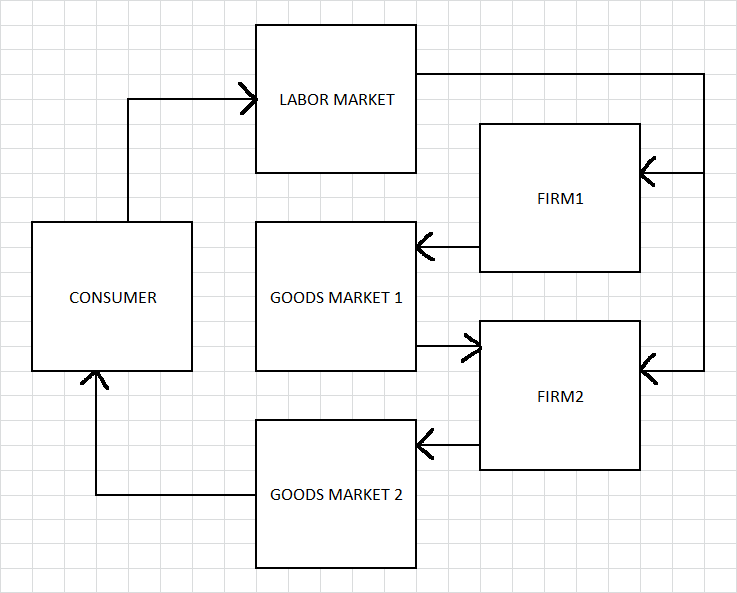intro
I'm looking at a simple model with 1 consumer, 2 goods and 2 firms.
I'm trying to get a price vector [p0, p1] that makes it work.
By makes it work, I mean, supply = demand in all 3 markets.
the problem
The problem is that I'm actually getting a set of price vectors that work.
Consider the picture below :
little details
consumer
There is one consumer who owns both firms and their profits and they go :
$$ u = \ln x + \gamma \ln b $$ where $b$ is leisure, and $\gamma$ is their relative want of leisure
And their budget is :
$$ M = wL + \pi_0+ \pi_1 $$ where $w$ is wage, $L$ is their time endowment ($n + b = L$), and $\pi_0$ and $\pi_1$ are each firm's profits.
Solving that gives $x$ and $b$, so labor supply is $n = L - b$.
firms[0]
The first firm, firms[0], uses just labor to make an intermediate good :
$$\pi_0 = p_0 \cdot z_0^{\alpha} - w z_0$$ where $0 < \alpha < 1$, $z_0$ is their labor demand, and $y_0 = z_0^{\alpha}$ is their output.
firms[1]
The other firm, firms[1], uses labor and firms[0]'s output, $y_0$.
$$\pi_1 = p_1 \cdot z_1^{\beta} \cdot (k_1+1)^{1-\beta} - w \cdot z_1 - p_0 \cdot k_1$$
Here, $z_1$ is their labor demand, $k_1$ is their intermediate goods demand, and $0 < \beta < 1$. Their output is $y_1=f_1(z_1,k_1)=z_1^{\beta} \cdot (k_1+1)^{1-\beta}$
This firm is almost constant returns to scale. That is, if it can make profit at some level $(z_1,k_1)$, then it will make more profit at $(az_1,ak_1)$ where $a>1$. That means that this firm won't settle on some profit maximizing allocation of $(z_1,k_1)$ since it will choose to keep buying more, at a given price level. So this firm uses $y_0$ as its limiting factor. And from there it decides how much labor to use.
Also, I made it so that $k_1$ could be 0. So like, depending on $[\alpha, \beta, \gamma, L]$ it could be that firms[0] doesn't even produce.
the markets
So the markets look like this :
Labor : n = z[0] + z[1] @ w
Middle : y[0] = k[1] @ p[0]
Final : y[1] = x @ p[1]
how i'm solving them
First, it's important to note that I do not know what I am doing. I'm doing this purely out of boredom, so please don't be surprised if the answer is something really obvious and I just plum don't know about it.
So I have a little function that takes some random price, say [1, 1], and uses that price vector to get the sum of squares of excess supply, exx. Like, it does "supply minus demand" for each market and squares it, and adds it to the total. It's my way of measuring how bad a price vector is.
Is there a way to measure how bad a price vector is?
Then it checks a bunch of price vectors around it, like [1+dp, 1], [1-dp, 1], [1, 1+dp] etc.. where dp is the size of the step. And when finds a point around it with a lower exx, it makes that the new price. And repeats. And when it doesn't find a better point, it shrinks dp and does it again.
the problem
The price vector I get changes depending on the starting point. And most of the time I get an exx = 0 (or very very near 0). The problem is that (just based on my graphing it), exx(p[0],p[1]) doesn't seem to be continuous. When I graph exx against p[0] (x-axis) and p[1] (y-axis), I get a whole set (a line) of price vectors and when I check them manually, they work.
centrally planned
When I solve the central planner problem it looks like this :
$$u= \ln x + \gamma \cdot \ln b$$
But $x=y_1=z_1^{\beta} \cdot (k_1+1)^{1-\beta}$ and $k_1=y_0=z_0^{\alpha}$ so that gives the following :
$$u = \beta \cdot \ln n_1 + (1-\beta) \cdot \ln (n_0^{\alpha} + 1) + \gamma \cdot \ln (L - n_0 - n_1)$$
Take $\frac{du}{dn_0}$ and $\frac{du}{dn_1}$ and that gives you something like :
$$0 = C_0 \cdot n_0^{1-\alpha} + C_1 \cdot n_0 + C_2$$
Where $[C_0, C_1, C_2]$ are constants made from the the exogenous variables $[\alpha, \beta, \gamma, L]$
Which is an equation I don't know how to solve but I do it numerically and I can verify that it is the utility-maximizing allocation.
I guess for me the important thing is the solution this gives is on that line I get when I graph $exx$ against $p_0$ and $p_1$. Important insofar as the algorithmic approach I used isn't too wrong, that is.
Anyhow, the reason I want the algorithmic approach to work is because I can easily add lots of consumers, firms, products, firm ownerships etc, and in order to do that, which is fun, I need to make sure my approach, in a technical sense, is sound and actually works.
questions
Does this problem have a unique solution?
Is there a proper way of solving for the solution(s)?
I guess that's all. I can possibly add a link to the work I did.
